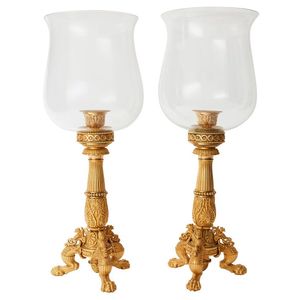George IV Ormolu Photophores with Glass Shades
A pair of George IV ormolu photophores, each standing on three leaf cast lion paw legs, with a central pendant pine cone boss, rising to an anthemion cast, beaded and reeded shaft supporting the stiff leaf and entrelac cast drip pan, and anthemion cast nozzle with bell shaped glass shades. Height 80 cm. Provenance: Mallett at Bourdon house, London, 1993, Mr J. Smiley, Woollahra. Other Notes: These magnificent ormolu hurricane candlesticks typify the antiquarian taste of George IV when he furnished Carlton House as Prince Regent. Similar to a 'Gilt bronze torchere of antique form' supplied circa 1805 and designed by Rundell Bridge and Rundell, and now at Windsor Castle. Rundells copied their design closely from contemporary records of the archaeological discoveries at Herculaneum in a folio publication, dedicated to Ferdinand IV of Naples, entitled 'Delle Antichita di Ercolano' volume 8, published in 1792, containing 21 plates of 'Candelabri'. Also influential were the designs of Giovanni Battista Piranesi and his publication 'Vasi, candelabri cippi, sarcofagi, tripodi, lucerne, ed ornamenti antichi?' of 1780.
You must be a subscriber, and be logged in to view price and dealer details.
Subscribe Now to view actual auction price for this item
When you subscribe, you have the option of setting the currency in which to display prices to $Au, $US, $NZ or Stg.
This item has been sold, and the description, image and price are for reference purposes only.
- Entrelac - In decorative arts, entrelac refers to a decorative technique that creates a woven or basket-weave-like pattern. The term "entrelac" is derived from the French word "entrelacer," which means "to interlace." In decorative arts, entrelac is often used to describe patterns that are created by interlacing or weaving together strips or bands of material.
In ceramics, entrelac is sometimes used to describe decorative patterns that are created by interlacing or weaving together strips or bands of clay. This technique can be used to create intricate designs and patterns on pottery, tiles, and other ceramic objects.
In other decorative arts, such as furniture, entrelac can be used to describe decorative inlays or marquetry, where wooden or other materials appear woven together to create intricate designs. This technique can be used to create decorative details on furniture, such as table tops and aprons, chair legs, and cabinet doors. - Anthemion - An anthemion is a classical decorative design element based on the acanthus flower that consists of a central circular or oval motif surrounded by radiating petals or leaves. It is often used as a border or frieze in architecture, furniture, and other decorative arts. The anthemion is derived from the palmette, a motif that was popular in ancient Greek and Roman art and architecture. It is often associated with the classical world and with Neoclassical style, and it is often used to add a sense of grandeur and formality to a design. The anthemion is also known as a honeysuckle or honeysuckle ornament. It continues to be used in a variety of contexts today, and it is often admired for its elegant and decorative qualities.
- George Iv - George IV (1762 ? 1830) was king of the United Kingdom of Great Britain and Ireland and king of Hanover from 1820, until his own death in 1830. From 1811 until his accession in 1820, he served as Prince Regent during his father's final mental illness.
In English furniture design, his reign from 1811 to 1830 is known as the Regency period. - Cone - A popular decorative motif based on the shape of the pine cone, and used in silver ceramics and furniture. Because of its shape it is most suitable for use as a finial.
- Ormolu - Ormolu was popular with French craftsmen in the 18th and 19th century for ornamental fittings for furniture, clocks and other decorative items. True ormolu is gilt bronze, that is bronze that has been coated with gold using a mercury amalgam. Due to the health risks associated with using mercury, this method of creating ormolu was discontinued in France in the 1830s. A substitute was developed consisting of about 75% copper and 25% zinc, however it was inferior to the bronze version. It was often lacquered to prevent it tarnishing.
- Bronze - An alloy of copper and tin, traditionally in the proportions of about 9 parts of copper to 1 part of tin.
The discovery of bronze in Western Asia in the 4th century enabled people to create metal objects which were superior to those previoulsy possible because of its strength and hardness, and it has been used throughout the world for weapons, coins, tools, statuary and other decorative items.
It is very fluid in a molten state, and its hardness, strength when set, and non-corrosive properties makes it most suitable for casting sculpture. - Circa - A Latin term meaning 'about', often used in the antique trade to give an approximate date for the piece, usually considered to be five years on either side of the circa year. Thus, circa 1900 means the piece was made about 1900, probably between 1895 and 1905. The expression is sometimes abbreviated to c.1900.
This item has been included into following indexes:
-
candelabra and candlesticks
- ceramic 127
- glass and crystal 295
-
candlesticks, material
- gilt and bronze 252
- ormolu and bronze 176
- lighting and lamps, material or type - hurricane lamps 20
- torcheres 113
